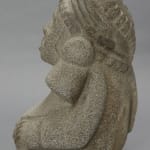Aztec Stone Sculpture of Chalchiuhtlicue, 1300 CE - 1550 CE
Stone
CK.0325
The Aztec civilization is perhaps the most celebrated of the ancient Mesoamerican cultures. Their empire stretched throughout northern Mexico and was surpassed in size only by that of the Incans....
The Aztec civilization is perhaps the most celebrated of the ancient Mesoamerican cultures. Their empire stretched throughout northern Mexico and was surpassed in size only by that of the Incans. Tenochtitlan (modern-day Mexico City) was the center of their religious and political systems. The city was composed of a group of island located in the center of Lake Texcoco, earning it the nickname “Venice of the New World.” By the time the Spanish Conquistadors arrived in the early 16th Century, led by the infamous Hernan Cortes, Tenochtitlan was by far larger than any city they could have seen in Europe. Today, the Aztec are remembered for their grand temple complex ruins, for their intricate calendar system, and for the few examples of their art that survive today. Aztec art was primarily ecclesiastical and is renowned for its powerful nature. Highly adept at working with stone, the Aztec artists created artworks that were both grand in scale, as evidenced in their temple architecture, and relatively small in size. Like many cultures, the Aztecs believed that many animals had supernatural symbolic associations. Therefore, although the Aztec gods were usually visualized in human form, most gods also had animal aspects. Moreover, it was believed that both men and gods could, at certain times, actually change themselves into powerful animals.Chalchiuhtlicue was an Aztec goddess of water, rivers, seas, streams, storms, and baptism. Universally revered at the time of the Spanish conquest, she was an important deity figure in the Postclassic Aztec realm of central Mexico. Her name means "she of the jade skirt,” and she was the wife (in some myths, sister) of the rain god, Tlaloc. In fact, it is after a great offense of this particular deity upon her, that Chalchiuhtlicue was said to create a monumental deluge that is the Aztec equivalent of the great biblical flood. Despite this rather morbid event (which is actually seen in Aztec mythology in much the same manner as biblical theology ie - a divine act of human purification), she is often seen as the embodiment of youthful beauty and noble ardor. And as can be noted in the present example of the kneeling type, Chalchihuitlicue's distinctive hairdressing denotes this high status. Her headdress always consisted of several broad bands with large round tassels falling from either side, while her attire consisted of an extravagant shawl adorned with tassels and a green skirt.



